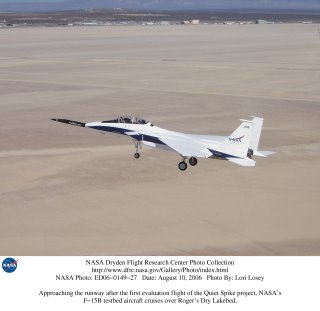Gulfstream, NASA Lab 'Spike' Sonic Booms

Gulfstream Aerospace and NASA's Dryden Flight Research Center have teamed in a project called Quiet Spike to investigate the suppression of sonic booms. The project centers around a retractable, 24-foot-long lance-like spike mounted on the nose of NASA Dryden's F-15B research testbed aircraft.
The spike, made of composite materials, creates three small shock waves that travel parallel to each other all the way to the ground, producing less noise than typical shock waves that build up at the front of supersonic jets. Before flying with the giant spike, NASA Dryden engineers and technicians, working alongside their Gulfstream counterparts, mounted it on the aircraft and conducted various structural tests on the ground.
"The partnership between Gulfstream and Dryden during Quiet Spike installation and ground testing on the F-15B has produced a wealth of valuable information. The duration of this flight test effort will prove to be exciting and informative for everyone involved," says Leslie Molzahn, NASA Dryden's operations engineer on the project.
Since the project's first flight, conducted on Aug. 10, several more flights have put the system's structural integrity to the test before moving on to sonic boom suppression measurements.
While these tests won't actually "quiet" the F-15's sonic boom, they will show that the spike's design is capable of use in a real flight environment. The flights are monitored in NASA Dryden's mission control.
"Working with Gulfstream has provided a significant advantage to this flight research project," NASA project manager Michael Toberman says. "This project merges Gulfstream's manufacturing expertise with NASA Dryden's flight test expertise."
Shockwaves develop around aircraft as they near Mach 1, or about 760 mph, the speed of sound at sea level. When an aircraft travels supersonically, the resulting shockwaves can produce a loud sonic boom that rattles windows and nerves on the ground under the path of the supersonic jet.
Because of sonic boom intensity, the Federal Aviation Administration prohibits supersonic flight over land, except in special military flight corridors. Gulfstream's Quiet Spike puts spike-induced sonic boom suppression theory to the test in the actual flight environment afforded by NASA's supersonic F-15B.
The aircraft has served NASA and industry in this role for years as a flying wind tunnel and supersonic testbed vehicle. Once the Quiet Spike has proven to be structurally sound, it can be incorporated with confidence onto advanced low-boom configuration aircraft to further lessen the impact of sonic booms.
"By changing length in-flight, Quiet Spike will demonstrate yet another way to shape the sonic boom," says Gulfstream spokesman Robert Baugniet. "It's a necessary step toward low boom aircraft design and truly quieting the sonic boom."


0 Comments:
Post a Comment
Subscribe to Post Comments [Atom]
<< Home